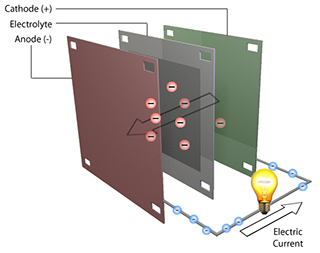CIHT Cell
Catalyst Induced Hydrino Transition Cell (CIHT Cell)
MechanismClick here for answers to frequently asked questions: FAQ Each CIHT cell comprises a positive electrode, the cathode, a negative electrode, the anode, and an electrolyte that also serves as a source of reactants to form Hydrinos. A Hydrino-producing reaction mixture creates electricity from H2O as the reactants are constituted with the migration of the electrons through an external circuit and ion mass transport through a separate internal path through the electrolyte to complete an electrical circuit. |
||||
 CIHT schematic |
The mechanism may be broken down to interdependent steps: 1. Assume CIHT is similar to an alkaline fuel cell, except that an electric current is passed through it and an inert atmosphere with trace H2O vapor surrounds the cathode, anode, and electrolyte.
2. Current is introduced, which produces hydrogen and oxygen from the electrolysis of the supplied trace H2O. Then, the cell is discharged for a much longer time than it was charged at essentially the same voltage maintained by the energy released from the hydrino reaction.
3. Nascent H2O is formed at the anode during discharge by oxidation of OH- and reaction with H. Hydrinos are then formed at the anode during cell discharge as a result of the atomic hydrogen reacting with the nascent water that serves as the catalyst to form the hydrinos.
4. When the hydrinos form, energy is given off that causes spontaneous electrochemical reactions to occur at both electrodes that result in a self-propagating electrochemical cycle wherein H2O is converted to hydrinos, electricity, and oxygen. Specifically, oxidation-reduction reactions of H2O involving oxygen and oxygen ion intermediates such as hydroxide, oxides, peroxides, and superoxides are involved in the spontaneous electrolysis of water powered by hydrino formation that in turn result in the formation of catalyst and hydrinos. The equivalent of Steps 1 and 2 occur continuously, except that no electricity has been applied during this process. Power is produced with a large net gain in electricity (e.g. 10X) over that to initiate the spontaneous electricity-producing process.
|
|||
Scale Up |
||||
|
To advance CIHT technology to commercialization, the essential milestone is scalability in terms of the size of the electrodes and the development of a bipolar plate comprising a back-to-back positive and negative electrode that can be stacked with intervening layers of electrolyte to form a stack of CIHT cells having a voltage that is the integer multiple of the number of cells. Brilliant Light Power has achieved both milestones with multiple times electrical gain operating over long duration at about the 10 W scale. |
||||
|
||||
![[BrLP]-Transparent-Logo-White-240px](https://brilliantlightpower.com/wp-content/uploads/2023/08/BrLP-Transparent-Logo-White-240px.png)

